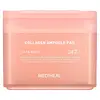What's inside
What's inside
 Key Ingredients
Key Ingredients

 Benefits
Benefits

 Concerns
Concerns

 Ingredients Side-by-side
Ingredients Side-by-side

Water
Skin ConditioningHamamelis Virginiana Water
AstringentGlycolic Acid
BufferingSodium Hydroxide
BufferingPolysorbate 20
EmulsifyingGlycerin
HumectantAloe Barbadensis Leaf Juice
Skin ConditioningParfum
MaskingCamellia Sinensis Leaf Extract
AntimicrobialDihydromyricetin
Skin ConditioningEpilobium Angustifolium Extract
Skin ConditioningNiacinamide
SmoothingSodium Bisulfite
AntioxidantButylene Glycol
HumectantSodium Benzoate
MaskingPotassium Sorbate
PreservativeCaprylyl Glycol
EmollientBenzoic Acid
MaskingDisodium EDTA
Ethylhexylglycerin
Skin ConditioningPhenoxyethanol
PreservativeWater, Hamamelis Virginiana Water, Glycolic Acid, Sodium Hydroxide, Polysorbate 20, Glycerin, Aloe Barbadensis Leaf Juice, Parfum, Camellia Sinensis Leaf Extract, Dihydromyricetin, Epilobium Angustifolium Extract, Niacinamide, Sodium Bisulfite, Butylene Glycol, Sodium Benzoate, Potassium Sorbate, Caprylyl Glycol, Benzoic Acid, Disodium EDTA, Ethylhexylglycerin, Phenoxyethanol
Water
Skin ConditioningGlycerin
HumectantGlycereth-26
Humectant1,2-Hexanediol
Skin ConditioningDiphenyl Dimethicone
EmollientTriethylhexanoin
MaskingBetaine
HumectantHydroxyacetophenone
AntioxidantHydrogenated Lecithin
EmulsifyingPolyglyceryl-10 Oleate
Skin ConditioningHydroxyethyl Urea
HumectantDipotassium Glycyrrhizate
HumectantSodium Citrate
BufferingAllantoin
Skin ConditioningOctyldodeceth-16
EmulsifyingXanthan Gum
EmulsifyingHydroxyethylcellulose
Emulsion StabilisingCollagen Extract
Skin ConditioningAdenosine
Skin ConditioningCitric Acid
BufferingDisodium EDTA
Olea Europaea Fruit Oil
MaskingButylene Glycol
HumectantPelargonium Graveolens Flower Oil
MaskingLavandula Angustifolia Oil
MaskingAnthemis Nobilis Flower Oil
MaskingCitrus Aurantium Dulcis Peel Oil
MaskingJuniperus Mexicana Oil
MaskingMangifera Indica Fruit Extract
Skin ConditioningLactobacillus Ferment
Skin ConditioningCeramide NP
Skin ConditioningMilk Protein Extract
Caprylyl Glycol
EmollientTripeptide-1
Skin ConditioningAcetyl Hexapeptide-8
HumectantCopper Tripeptide-1
Skin ConditioningPalmitoyl Tripeptide-1
Skin ConditioningPalmitoyl Pentapeptide-4
Skin ConditioningWater, Glycerin, Glycereth-26, 1,2-Hexanediol, Diphenyl Dimethicone, Triethylhexanoin, Betaine, Hydroxyacetophenone, Hydrogenated Lecithin, Polyglyceryl-10 Oleate, Hydroxyethyl Urea, Dipotassium Glycyrrhizate, Sodium Citrate, Allantoin, Octyldodeceth-16, Xanthan Gum, Hydroxyethylcellulose, Collagen Extract, Adenosine, Citric Acid, Disodium EDTA, Olea Europaea Fruit Oil, Butylene Glycol, Pelargonium Graveolens Flower Oil, Lavandula Angustifolia Oil, Anthemis Nobilis Flower Oil, Citrus Aurantium Dulcis Peel Oil, Juniperus Mexicana Oil, Mangifera Indica Fruit Extract, Lactobacillus Ferment, Ceramide NP, Milk Protein Extract, Caprylyl Glycol, Tripeptide-1, Acetyl Hexapeptide-8, Copper Tripeptide-1, Palmitoyl Tripeptide-1, Palmitoyl Pentapeptide-4
 Reviews
Reviews

Ingredients Explained
These ingredients are found in both products.
Ingredients higher up in an ingredient list are typically present in a larger amount.
Butylene Glycol (or BG) is used within cosmetic products for a few different reasons:
Overall, Butylene Glycol is a safe and well-rounded ingredient that works well with other ingredients.
Though this ingredient works well with most skin types, some people with sensitive skin may experience a reaction such as allergic rashes, closed comedones, or itchiness.
Learn more about Butylene GlycolCaprylyl Glycol is a humectant and emollient, meaning it attracts and preserves moisture.
It is a common ingredient in many products, especially those designed to hydrate skin. The primary benefits are retaining moisture, skin softening, and promoting a healthy skin barrier.
Though Caprylyl Glycol is an alcohol derived from fatty acids, it is not the kind that can dry out skin.
This ingredient is also used as a preservative to extend the life of products. It has slight antimicrobial properties.
Learn more about Caprylyl GlycolDisodium EDTA plays a role in making products more stable by aiding other preservatives.
It is a chelating agent, meaning it neutralizes metal ions that may be found in a product.
Disodium EDTA is a salt of edetic acid and is found to be safe in cosmetic ingredients.
Learn more about Disodium EDTAGlycerin is already naturally found in your skin. It helps moisturize and protect your skin.
A study from 2016 found glycerin to be more effective as a humectant than AHAs and hyaluronic acid.
As a humectant, it helps the skin stay hydrated by pulling moisture to your skin. The low molecular weight of glycerin allows it to pull moisture into the deeper layers of your skin.
Hydrated skin improves your skin barrier; Your skin barrier helps protect against irritants and bacteria.
Glycerin has also been found to have antimicrobial and antiviral properties. Due to these properties, glycerin is often used in wound and burn treatments.
In cosmetics, glycerin is usually derived from plants such as soybean or palm. However, it can also be sourced from animals, such as tallow or animal fat.
This ingredient is organic, colorless, odorless, and non-toxic.
Glycerin is the name for this ingredient in American English. British English uses Glycerol/Glycerine.
Learn more about GlycerinWater. It's the most common cosmetic ingredient of all. You'll usually see it at the top of ingredient lists, meaning that it makes up the largest part of the product.
So why is it so popular? Water most often acts as a solvent - this means that it helps dissolve other ingredients into the formulation.
You'll also recognize water as that liquid we all need to stay alive. If you see this, drink a glass of water. Stay hydrated!
Learn more about Water